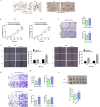Fibronectin promotes tumor angiogenesis and progression of non-small-cell lung cancer by elevating WISP3 expression via FAK/MAPK/ HIF-1α axis and activating wnt signaling pathway
- PMID: 37468964
- PMCID: PMC10355078
- DOI: 10.1186/s40164-023-00419-w
Fibronectin promotes tumor angiogenesis and progression of non-small-cell lung cancer by elevating WISP3 expression via FAK/MAPK/ HIF-1α axis and activating wnt signaling pathway
Abstract
Background: Fibronectin, an extracellular matrix protein, has been reported to be associated with heterogeneous cancer stemness, angiogenesis and progression in multiple cancer types. However, the roles and the underlying mechanism of fibronectin on the progression NSCLC need to be further elucidated.
Methods: Public dataset such as Kaplan-Meier Plotter was used to determine the prognostic significance of genes. The correlation of different protein expression in clinical and xenograft tissues was tested by immunohistochemistry experiment. Both in vitro and in vivo experiments were performed to determine the role of fibronectin on the tumor growth, metastasis, and angiogenesis in NSCLC. The activation of key signaling pathway under fibronectin was examined by WB assay. RNA-seq was applicated to screening the target gene of fibronectin. Rescue experiment was performed to confirm the role of target gene in fibronectin-mediated function in NSCLC. Finally, luciferase and CHIP assays were used to elucidate the mechanism by which fibronectin regulated the target gene.
Results: Our results revealed that fibronectin was up-regulated in cancer tissues compared with the normal ones in NSCLC patients. Dish- coated fibronectin enhanced the tumor growth, metastasis, and angiogenesis of NSCLC in vitro and in vivo by promoting EMT and maintaining stemness of NSCLC cells. As expected, fibronectin activated FAK and its downstream MAPK/ERK signaling pathway. WISP3 was screened as a potential target gene of fibronectin. Interestingly, WISP3 effectively activated Wnt signaling pathway, and knockdown of WISP3 effectively blocked the influence of fibronectin on the migration, invasion and vascular structure formation potential of NSCLC cells. Our data also manifested that fibronectin elevated the transcription of WISP3 gene by promoting the binding of HIF-1α to the promoter region of WISP3 in NSCLC cells.
Conclusions: Our findings sketched the outline of the route for fibronectin exert its role in NSCLC, in which fibronectin activated downstream FAK and MAPK/ERK signaling pathways, and mediated the accumulation of HIF-1α. Then, HIF-1α enabled the transcription of WISP3, and subsequently promoted the activation of Wnt signaling pathway, and finally enhanced the tumor growth, metastasis, and angiogenesis in NSCLC.
Keywords: Angiogenesis; Fibronectin; MAPK/ERK; Metastasis; NSCLC; WISP3; Wnt.
© 2023. The Author(s).
Conflict of interest statement
The authors declare no competing interests.
Figures









Similar articles
-
MicroRNA-330-3p promotes cell invasion and metastasis in non-small cell lung cancer through GRIA3 by activating MAPK/ERK signaling pathway.J Hematol Oncol. 2017 Jun 19;10(1):125. doi: 10.1186/s13045-017-0493-0. J Hematol Oncol. 2017. Retraction in: J Hematol Oncol. 2020 Oct 22;13(1):142. doi: 10.1186/s13045-020-00969-0. PMID: 28629431 Free PMC article. Retracted.
-
Silencing of WISP3 suppresses gastric cancer cell proliferation and metastasis and inhibits Wnt/β-catenin signaling.Int J Clin Exp Pathol. 2014 Sep 15;7(10):6447-61. eCollection 2014. Int J Clin Exp Pathol. 2014. PMID: 25400723 Free PMC article.
-
Midkine Is a Potential Therapeutic Target of Tumorigenesis, Angiogenesis, and Metastasis in Non-Small Cell Lung Cancer.Cancers (Basel). 2020 Aug 24;12(9):2402. doi: 10.3390/cancers12092402. Cancers (Basel). 2020. PMID: 32847073 Free PMC article.
-
Fibroblast growth factor 11 (FGF11) promotes non-small cell lung cancer (NSCLC) progression by regulating hypoxia signaling pathway.J Transl Med. 2021 Aug 17;19(1):353. doi: 10.1186/s12967-021-03018-7. J Transl Med. 2021. PMID: 34404435 Free PMC article.
-
Vasculogenesis and angiogenesis initiation under normoxic conditions through Wnt/β-catenin pathway in gliomas.Rev Neurosci. 2018 Jan 26;29(1):71-91. doi: 10.1515/revneuro-2017-0032. Rev Neurosci. 2018. PMID: 28822229 Review.
Cited by
-
Targeting RECQL4 in hepatocellular carcinoma: from prognosis to therapeutic potential.BMC Med Genomics. 2025 Feb 25;18(1):38. doi: 10.1186/s12920-025-02107-6. BMC Med Genomics. 2025. PMID: 40001159 Free PMC article.
-
Exploring the mechanism of fibronectin extra domain B in the tumor microenvironment and implications for targeted immunotherapy and diagnostics (Review).Mol Med Rep. 2025 Jun;31(6):160. doi: 10.3892/mmr.2025.13525. Epub 2025 Apr 11. Mol Med Rep. 2025. PMID: 40211711 Free PMC article. Review.
-
Advanced Lung-on-a-Chip Technology: Mimicking the Complex Human Lung Microenvironment.Int J Biol Sci. 2025 Jan 1;21(1):17-39. doi: 10.7150/ijbs.105702. eCollection 2025. Int J Biol Sci. 2025. PMID: 39744426 Free PMC article.
-
Wnt signaling pathways in biology and disease: mechanisms and therapeutic advances.Signal Transduct Target Ther. 2025 Apr 4;10(1):106. doi: 10.1038/s41392-025-02142-w. Signal Transduct Target Ther. 2025. PMID: 40180907 Free PMC article. Review.
-
Visualizing the Tumor Microenvironment: Molecular Imaging Probes Target Extracellular Matrix, Vascular Networks, and Immunosuppressive Cells.Pharmaceuticals (Basel). 2024 Dec 10;17(12):1663. doi: 10.3390/ph17121663. Pharmaceuticals (Basel). 2024. PMID: 39770505 Free PMC article. Review.
References
-
- Bao Y, Yang X, Men Y, Kang J, Sun X, Zhao M, et al. Postoperative radiotherapy improves survival of patients with ypN2 non-small cell lung cancer after neoadjuvant chemotherapy followed by surgery - A propensity score matching study of the Surveillance, Epidemiology, and end results database. Thorac cancer. 2022;13(3):404–11. doi: 10.1111/1759-7714.14273. - DOI - PMC - PubMed
Grants and funding
LinkOut - more resources
Full Text Sources
Research Materials
Miscellaneous

